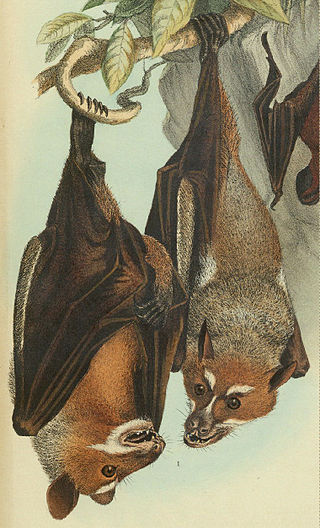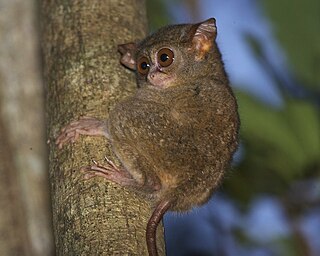
The ashy woodpecker is a species of bird in the woodpecker family Picidae. It is endemic to Sulawesi and surrounding islands in Indonesia. There are two subspecies, the nominate race M. f. fulvus, which is found in northern Sulawesi, the islands of Lembeh and Manterawu, and the archipelagos of Togian and Banggai; and M. f. wallacei, from southern Sulawesi and the islands of Muna and Buton. The second subspecies is named for the collector and scientist Alfred Russel Wallace.

The Wallace's or Sulawesi stripe-faced fruit bat is a species of megabat in the family Pteropodidae. It is endemic to Sulawesi and the nearby Togian Islands of Indonesia. Cave paintings resembling these bats have been found in Australia, where bats of this kind are not otherwise known.

Tarsius is a genus of tarsiers, small primates native to islands of Southeast Asia. Until 2010, all tarsier species were typically assigned to this genus, but a revision of the family Tarsiidae restored the generic status of Cephalopachus and created a new genus Carlito.
Pygmaeconus wallacei is a species of sea snail, a marine gastropod mollusk in the family Conidae, the cone snails and their allies.
Wallace's tarsier, Tarsius wallacei, is a species of Sulawesi tarsier. It is found in the forests of what is referred to geologically as the neck of Sulawesi where there are two separate populations. It is a small brown arboreal primate of the infraorder Tarsiiformes less than 15 cm (6 in) long.
Rhysodinae is a subfamily in the family Carabidae. There are 19 genera and at least 380 described species in Rhysodinae. The group of genera making up Rhysodinae had been treated as the family Rhysodidae in the past, and subsequent DNA analysis then placed it within Carabidae, where it was sometimes treated as the tribe Rhysodini, but the most recent analyses place it as a subfamily in a clade along with subfamilies Paussinae and Siagoninae, forming a sister to the remaining Carabidae.

Tangarona is a genus of wrinkled bark beetles in the family Carabidae. Tangarona pensa, found in New Zealand, is the only species of this genus.

Omoglymmius is a genus of wrinkled bark beetles in the subfamily Rhysodinae, found on every continent except Africa and Antarctica. There are at least 150 species in Omoglymmius.
Yamatosa is a genus of wrinkled bark beetles in the family Carabidae, found in Asia.
Omoglymmius astraea is a species of beetle in the subfamily Rhysodinae. It was described by R.T. Bell & J.R. Bell in 1988. It is known from Mount Muajat in North Sulawesi (Indonesia).
Omoglymmius brendelli is a species of beetle in the subfamily Rhysodinae. It was described by R.T. Bell & J.R. Bell in 1988. It is known from the central part of Sulawesi (Indonesia), near the Gulf of Tolo. The specific name brendelli honors M. J. D. Brendell, collector of the holotype.
Omoglymmius cupedoides is a species of beetle in the subfamily Rhysodinae. It was described by R.T. Bell & J.R. Bell in 1993. It is known from Madang, Papua New Guinea, where it was collected in 1896.
Omoglymmius ferrugatus is a species of beetle in the subfamily Rhysodinae. It was described by R.T. Bell & J.R. Bell in 1988. It is known from Potil Kecil in Banggai Archipelago, east of Sulawesi (Indonesia).
Omoglymmius gressitti is a species of beetle in the subfamily Rhysodidae. It was described by R.T. Bell and J.R. Bell in 1985. It is known from Mount Missim near Wau, Papua New Guinea. It is named for J. L. Gressitt and his wife, Margaret, "for their kind hospitality and assistance on our field trip to the Wau Ecological Institute".
Omoglymmius multicarinatus is a species of beetle in the subfamily Rhysodinae. It was described by R.T. Bell & J.R. Bell in 1993. It is known from the northern peninsula of Sulawesi, Indonesia.
Omoglymmius sabah is a species of beetle in the subfamily Rhysodinae. It was described by R.T. Bell & J.R. Bell in 1993. It is known from Mount Kinabalu in Sabah, Malaysian Borneo. The type series was collected at elevations of 500–900 m (1,600–3,000 ft) above sea level.
Omoglymmius seriatus is a species of beetle in the subfamily Rhysodinae. It was described by R.T. Bell & J.R. Bell in 1988. It is known from Mount Tambusisi in Central Sulawesi (Indonesia), near the Gulf of Tomini.

Ross Taylor Bell was an American entomologist with particular interest in the invertebrate natural history of Vermont, United States, and carabid beetles. Together with his wife, Joyce Bell, his work at the University of Vermont was largely taxonomic, where they described more than 75% of the rhysodine species known to science. Ross also wrote a number of seminal papers in his chosen field.
Cyrtodactylus wallacei is a species of gecko, a lizard in the family Gekkonidae. The species is endemic to Sulawesi.





